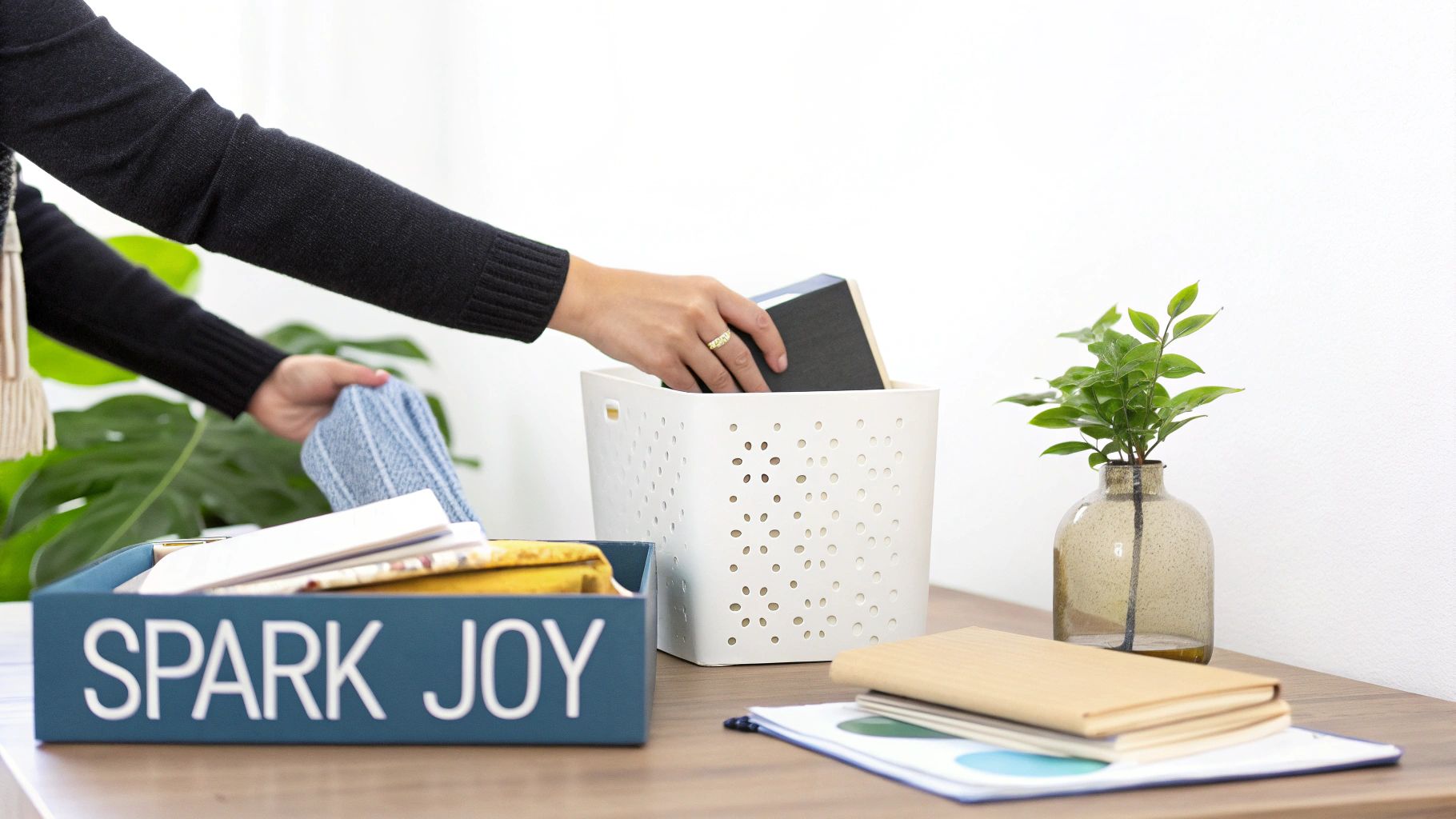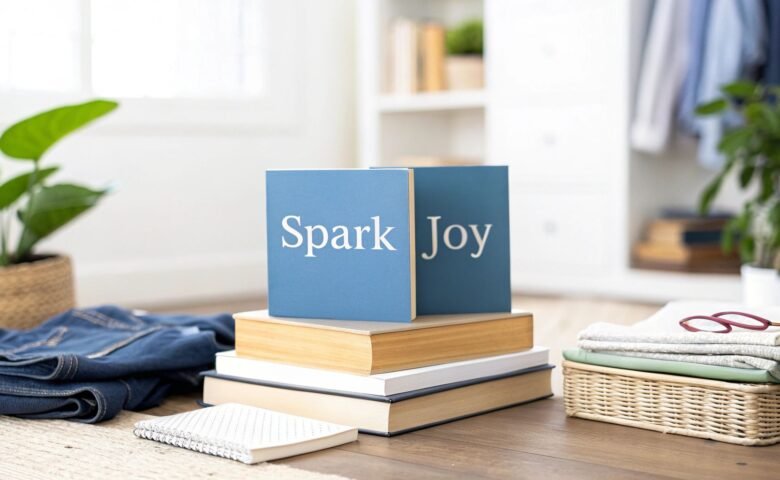Understanding the Joy-Centered KonMari Philosophy

The KonMari Method isn’t just another decluttering trend; it’s a thoughtful way to create a home filled with items you truly cherish. At its heart is the surprisingly powerful idea of sparking joy. Instead of deciding what to throw away, the KonMari Method encourages you to identify what you love.
This shift in perspective makes decluttering feel less like a loss and more like a celebration of your favorite things. It transforms a chore into a journey of self-discovery.
The KonMari Method, created by Marie Kondo, follows a specific order: clothes, books, papers, komono (miscellaneous items), and lastly, sentimental items. This structured approach is key to its success. Starting with clothes, for instance, helps you hone your “joy-checking” skills on less emotionally charged items before tackling sentimental treasures.
The KonMari Method: A Step-by-Step Guide
Marie Kondo popularized the KonMari Method in her 2011 book The Life-Changing Magic of Tidying Up and her Netflix series. The five categories – clothes, books, papers, komono, and sentimental items – are always tackled in this specific order. This intentional order starts with simpler categories like clothing and builds towards more challenging ones like sentimental items.
Want a deeper dive into the KonMari Method’s steps? Check out this helpful guide: The KonMari Method Explained. You might also find this interesting: How to master…
The Power of Joy
Focusing on joy creates a special bond between you and your possessions. It’s not about a perfectly tidy house; it’s about filling your space with items that truly resonate with you. This mindful approach helps you discover what’s important, leading to a more intentional and fulfilling life. Plus, the process of identifying joy can be surprisingly insightful, revealing your values and priorities.
Beyond Tidying: A Lifestyle Change
By choosing joy, you naturally create a space that supports your well-being. This mindful approach to your possessions goes beyond just tidiness; it contributes to your mental clarity and sense of peace. It’s important to note that the KonMari Method isn’t a quick fix. It requires commitment and a willingness to reflect on your relationship with your belongings. This conscious approach fosters lasting change, preventing clutter from returning.
Setting The Stage: Preparing Your KonMari Journey
Embarking on the KonMari Method is more than simply tidying up; it’s a conscious commitment to mindful living and appreciating your belongings. This journey requires thoughtful preparation to ensure a smooth and successful transformation of your home. Before you even think about picking up a single item, there are key steps to take.
Visualizing Your Ideal Lifestyle
The KonMari Method begins with introspection. Visualize your ideal lifestyle. Ask yourself what kind of environment you want to live in and how you want to feel in your home. This vision becomes your north star throughout the tidying process, guiding your decisions, especially the difficult ones. Imagine, for example, a serene and inviting living room; this image will help you discern which items truly contribute to that atmosphere.
Expressing Gratitude For Your Home And Belongings
The next step might seem unusual: express gratitude for your home and everything in it. Thanking your belongings for their service might feel unconventional, but it establishes a positive and respectful tone for the entire process. This shift in mindset transforms decluttering from a negative act of discarding into a positive act of carefully choosing what sparks joy. It acknowledges the role each item has played, making letting go a more thoughtful experience.
Creating A Realistic Timeline
It’s important to set realistic expectations. The KonMari Method isn’t a quick fix; it’s a journey. The entire process can take up to six months, depending on the size of your home and the volume of possessions you have. Tackling an entire house involves sorting through potentially thousands of items across five categories: clothing, books, papers, komono (miscellaneous items), and sentimental items. This time investment is essential for making considered decisions about each item. The KonMari Method has a demonstrably significant impact, but it requires dedication and patience.
To help you plan, let’s look at a realistic timeline based on different home sizes:
KonMari Method Timeline Expectations
| Category | Small Home/Apartment | Medium Home | Large Home |
|---|---|---|---|
| Clothing | 1-2 days | 2-3 days | 3-4 days |
| Books | 1 day | 1-2 days | 2-3 days |
| Papers | 1 day | 1-2 days | 2 days |
| Komono (Miscellaneous Items) | 2-3 days | 3-4 days | 4-5 days |
| Sentimental Items | 1-2 days | 2-3 days | 3-4 days |
| Total Time | 6-9 days | 9-14 days | 14-18 days |
This table outlines a dedicated tidying schedule. Remember, these are estimates, and you can adjust the timeframe to fit your lifestyle. Breaking the process down into manageable chunks makes it less overwhelming.
Preparing Your Family
If you share your living space, communication is key. Talk to your family members about the KonMari Method and what it involves. Explain the process and its benefits, highlighting that the focus is on choosing joy, not just getting rid of things. This helps them understand and respect your journey, even if they choose not to participate fully.
Embracing The Tidying Festival
Finally, approach this process as a special event, a “tidying festival,” rather than a mundane chore. This positive mindset builds momentum and frames the experience as a unique opportunity for positive change. It also creates a sense of a defined beginning and end, making the entire project feel less daunting and more achievable. This dedicated approach will yield more lasting and meaningful results than regular cleaning ever could. By setting the right mindset and a clear plan, you’ll be well-prepared to begin your KonMari journey with intention and purpose.
Clothes First: Mastering the Foundation KonMari Step

The KonMari Method, a popular tidying approach, starts with clothing. This serves as an excellent starting point to help you identify what truly sparks joy. Mastering this first step sets the stage for success with the rest of the method.
The Power of the Clothing Pile
The initial step may seem daunting: gather every single piece of clothing you own into one enormous pile. This includes everything from closets and drawers to off-season storage and even clothes you’re currently wearing. This seemingly overwhelming task is crucial for several reasons.
It creates a visual impact, making you aware of the sheer volume of clothing you own. This can be a powerful moment in changing how you view what you “need.” It also ensures consistency, allowing you to evaluate everything against the same criteria, preventing a fragmented and less effective tidying experience.
Identifying True Joy
Hold each item and ask yourself the key KonMari question: “Does this spark joy?” This is not about practicality or necessity; it’s about the immediate feeling you get. It’s important to recognize the difference between genuine joy and feelings of guilt or obligation.
Keeping items “just in case” or because you feel you should like them clutters your space and your mind. For example, a dress bought for a special occasion that remains unworn might bring guilt instead of joy. Letting go is perfectly okay. This process helps you understand your true preferences.
The Art of KonMari Folding
After identifying your joy-sparking clothes, the KonMari Method introduces a unique folding technique. Instead of stacking, each item is folded into a compact rectangle, standing upright in drawers like files.
This maximizes both space and visibility. No more digging through piles! Everything is easily accessible, like a beautifully curated display in your own home.
Addressing Common Challenges
Certain types of clothing often present challenges. Seasonal clothes, shared wardrobes, and those “sometimes” items can be tricky. The KonMari Method offers solutions. Evaluate seasonal items during their respective season. For shared wardrobes, each person should follow their own joy-sparking process. Those “sometimes” pieces often point to an underlying reason for inconsistent joy—perhaps they need repair or altering.
KonMari Folding: A Comparison
To further illustrate the benefits of KonMari folding, let’s take a look at the following comparison:
| Clothing Type | Traditional Method | KonMari Method | Space Savings | Benefits |
|---|---|---|---|---|
| T-shirts | Stacked | Folded upright | Significant | Increased visibility, easier access |
| Jeans | Folded and stacked | Folded upright | Moderate | Prevents wrinkles, easier selection |
| Sweaters | Folded and stacked | Folded upright | Significant | Prevents stretching, better organization |
| Socks | Balled or knotted | Folded or rolled | Moderate | Extends lifespan, tidier drawers |
This table highlights how KonMari folding leads to a more organized and efficient wardrobe. By folding items upright, you can see everything at a glance and access items without disturbing the rest of your drawer. This not only saves space but also makes getting dressed each morning a more streamlined process.
By starting with clothes and mastering the KonMari Method’s first step, you’ll build a solid foundation for tackling the other categories and transforming your home into a joy-filled space. You’ll learn to discern what truly matters and create a home that reflects your values and consistently sparks joy.
Knowledge Items: The KonMari Method for Books & Papers
After tidying clothes, the KonMari Method™ focuses on books and papers, two categories that can be surprisingly difficult. These items represent information and knowledge, making them harder to part with than clothes. Let’s explore how to apply the KonMari Method™ to these knowledge items.
KonMari and Books: Keeping What Truly Inspires
Books can hold sentimental value, symbolize aspirations, or simply collect dust. The KonMari Method™ encourages holding each book and asking yourself, “Does this spark joy?” This question helps determine if a book truly resonates with you or if you’re keeping it out of obligation. For example, an unused cookbook might represent a desire to cook more, not enjoyment.
Letting Go of Aspirational Reading
Many keep books they intend to read someday. If a book hasn’t sparked enough joy to be read yet, it likely won’t in the future. Be honest. Acknowledge the value the book represented and let it go, making space for books that genuinely enrich your life. Consider donating unwanted books to give them a new home.
KonMari and Papers: Practical Systems for Essential Documents
Papers are often the least sentimental but most overwhelming category. The KonMari Method™ for papers prioritizes practicality and efficient systems. Instead of piles, create categorized areas for essential documents:
- Actionable: Bills, forms to complete
- Pending: Documents needing a response or further action
- Important: Official records, legal documents
- Miscellaneous: Other necessary papers
This system eliminates clutter and ensures important information is easily accessible. You’ll move from disorganized stacks to a streamlined system.
Overcoming the “I Might Need This Someday” Mentality
The “I might need this someday” thought is a common obstacle. Realistically, these “someday” scenarios rarely happen. If information is easily found online, a physical copy might be unnecessary, freeing up physical space. Digitizing important documents offers secure and easily accessible backups.
By using the KonMari Method™ for books and papers, you’ll declutter your space and gain mental clarity. This process strengthens decision-making skills and builds a strong foundation for tackling more challenging categories later on. You’ll curate a collection of items that truly enrich your life.
Conquering Komono: Tackling Your Diverse Possessions

The KonMari Method progresses to komono, the most diverse and often challenging category. This includes everything from kitchen gadgets and bathroom supplies to hobby materials and electronics. Due to its varied nature, komono requires a strategic approach.
Breaking Down Komono: Subcategories For Success
To avoid feeling overwhelmed, break the komono category into smaller, manageable subcategories. This might include:
- Kitchen komono: Utensils, appliances, cookware
- Bathroom komono: Toiletries, makeup, hair accessories
- Technology komono: Electronics, cables, gadgets
- Hobby komono: Craft supplies, sports equipment
- Miscellaneous komono: CDs, DVDs, tools
This makes the process less daunting and allows a more focused approach. Tackling kitchen items at once is much easier than facing the entire komono category.
Evaluating Utility Items: The Joy In Function
Many komono items are functional. The “spark joy” principle still applies, but it may manifest differently. Consider if an item fulfills its purpose effectively. A well-designed kitchen tool might spark joy through its ease of use. Joy can be found in the satisfaction of a tool working well.
Letting Go of the “Just in Case” Mentality
Komono is where the “just in case” mentality thrives. We keep rarely used items, thinking we might need them someday. This leads to clutter. When evaluating, consider how likely you are to actually use them. Think about the cost of replacing an item versus storing it long-term. Replacing an item is often more practical than keeping it for years.
Creating Intuitive Organization Systems
As you declutter each subcategory, think about how to organize the remaining items. The KonMari Method emphasizes intuitive systems. This could involve clear storage containers, drawer dividers, or designated shelves. The goal is to create a home for everything, making it easy to maintain tidiness. You might be interested in: How to master…
Specific Guidance For Komono Subcategories
Each komono subcategory has unique considerations. With electronics, assess their functionality and relevance. For bathroom products, check expiration dates and discard outdated items. In the kitchen, focus on regularly used tools and those that bring genuine satisfaction when cooking.
Remember, the goal is to surround yourself with items that serve a purpose and bring you joy, whether through their beauty, functionality, or the positive feelings they evoke. By applying these principles, you can conquer the diverse world of komono and create a more organized and joyful home.
Sentimental Items: The Final KonMari Method Challenge
The final stage of the KonMari Method brings you to the most emotionally charged category: sentimental items. This includes everything from childhood mementos and family heirlooms to photographs and gifts. This category often feels the most challenging, but it can also be the most rewarding.
Understanding the Emotional Weight of Sentimental Items
Sentimental items hold memories and emotions, making it harder to decide what to keep. Unlike clothes or books, these items often represent significant people or moments in our lives. A faded photograph might represent a cherished family vacation, while a handmade gift holds the love of the giver. This emotional connection makes decluttering this category a delicate process.
Honoring Memories Without Keeping Everything
The KonMari Method doesn’t advocate discarding all sentimental items. Instead, it encourages you to keep only those that truly spark joy. This might mean keeping a few representative photos from an event rather than every single picture. This careful selection actually enhances the significance of the items you choose to keep. For example, instead of storing boxes of childhood drawings, choose a few favorites to frame and display.
Creative Display Ideas for Treasured Possessions
Creating designated spaces to display sentimental items can further elevate their importance. A shadow box can showcase cherished concert tickets, while a memory jar can hold small trinkets. Turning old t-shirts into a quilt transforms sentimental clothing into a functional and heartwarming piece. This transforms sentimental items from clutter into meaningful décor.
Addressing the Guilt of Discarding Gifts
Gifts often carry the weight of obligation. The KonMari Method emphasizes gratitude for the giver’s thoughtfulness, even if the gift itself doesn’t spark joy. It’s okay to let go of a gift while still cherishing the sentiment behind it. Donating or repurposing a gift can alleviate guilt while giving the item a new life. The giver’s intentions are honored, even if the item no longer serves you.
Practical Solutions for Preserving Family History
Family heirlooms and historical documents can feel particularly difficult to declutter. Consider digitizing old photos and letters to preserve family history without the physical clutter. Creating a digital archive ensures memories are safe and accessible while freeing up physical space. Sharing these digitized memories with family members creates connections and spreads the joy.
Sensitive Approaches to Children’s Artwork
Children’s artwork is a common source of sentimental clutter. Involve your children in the selection process, allowing them to choose their favorite creations. Photographing artwork before letting it go provides a digital record. Creating a dedicated “art gallery” space in your home allows you to display cherished pieces. This helps teach children to appreciate their creativity while practicing mindful organization.
By tackling sentimental items with intention and respect, the final KonMari category often becomes the most rewarding, bringing not only a tidier home but also emotional clarity. This creates space both physically and emotionally, allowing you to focus on what truly matters.
Living the KonMari Lifestyle: Maintaining Your Transformation

Completing the KonMari Method™ steps is a significant achievement. But the real magic lies in maintaining your newly organized space. This section explores how to integrate the KonMari principles into your daily life, ensuring your home remains a haven of joy and clarity.
Integrating KonMari Into Everyday Life
The KonMari Method isn’t just a one-time cleaning spree. It’s a shift in how you relate to your belongings. This involves continually evaluating what you bring into your home and how you care for what you already own. It’s about consciously choosing what sparks joy.
This mindful approach prevents clutter from creeping back in. It also helps maintain a sense of calm and order. By being intentional about your possessions, you can enjoy the lasting benefits of the KonMari Method.
Practical Systems For New Items
One key to maintaining a KonMari-organized home is having practical systems for handling new items. This includes daily mail management, thoughtful gift-receiving, and a mindful approach to shopping.
For example, designate a specific spot for incoming mail. Deal with it immediately, discarding junk mail and filing important documents. This prevents paper piles from accumulating.
Mindful Consumption: The Joy-Checking Principle For Purchases
Applying the joy-checking principle to purchases is crucial for preventing future clutter. Before buying anything, ask yourself: “Does this spark joy? Do I truly need this?”
This practice helps prevent impulse buys. It ensures every new item adds value to your life. This thoughtful approach to consumption helps you appreciate what you already own, reducing the desire for unnecessary items.
Maintenance Routines That Work
Maintaining a KonMari-organized home doesn’t require hours of daily work. Small, consistent habits are key. Put things back in their designated places after use.
Take a few minutes each day to tidy up any clutter hotspots. These simple routines prevent clutter from building up. They help maintain the sense of calm you achieved through the KonMari Method.
Seasonal Refresh Strategies
Just as your wardrobe changes with the seasons, your home can benefit from a seasonal refresh. This is a great time to re-evaluate your belongings and ensure they still spark joy.
You might pack away winter clothes in the summer, making room for what you need now. Changing decorative accents to reflect the current season keeps your home feeling fresh and inspiring.
Adapting KonMari During Life Transitions
Life transitions, like moving or welcoming children, present unique challenges. The KonMari principles remain valuable tools during these times. When moving, use the opportunity to declutter before packing. Ensure you only bring joy-sparking items to your new home. Check out our guide on How to master…
When downsizing, the KonMari method helps you decide what to keep, donate, or discard. It empowers you to make informed decisions about your possessions.
Real-Life Success Stories: Lasting Freedom and Clarity
Many people find that maintaining KonMari practices creates lasting freedom and clarity. They report feeling less stressed and more in control of their environment.
Their homes become havens of peace, reflecting their values and priorities. By consistently applying the KonMari principles, these individuals experience a deeper sense of joy and fulfillment.
Ready to transform your home into a space that sparks joy? Explore our range of high-quality home organizers and storage solutions at LAMU and begin your journey to a more organized and fulfilling life.








Leave a comment